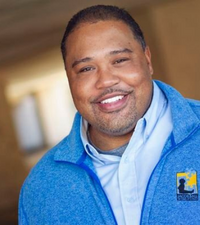
New NASSP President Aaron Huff is in his fifth year as principal of Benjamin Bosse High School in Evansville, IN. The variety of education roles Huff has held—for example, working in elementary, middle, and high schools with a wide range of demographics—has given him a well-rounded perspective on school leadership. We asked him about his excitement at being able to dive in and advocate for principals at the national level.
Tell us about your background in education.
I took a non-traditional track toward leadership. I started out as an afterschool program coordinator, and I did some basketball coaching during that time. Then I got my counseling license and became an elementary school counselor and coached basketball and football. My first year as a counselor, I was placed in a leadership cadre that our school district established in partnership with Brown University in Providence, RI. My cadre encouraged me to sit for my principal licensure, so I took the test.
I then became a high school dean in charge of discipline. After two years in that position, I moved over to the junior high level for one year and then I became a principal at another junior high for six years. This is my fifth year sitting in the principal seat at my current school. I was never a classroom teacher, but I displayed leadership capacity at each point in my career.
Describe what makes your school unique.
Bosse is an urban school serving a diverse student population, and the English Language Learner population is pretty high. I’m proud that our school really doesn’t have social cliques. You’ll see a student in fine arts and band hanging with the basketball player, and a tennis player hanging with a theater kid. We are so small that we don’t get these isolated cliques.
Our population presents its own set of challenges and provides ample opportunities to think creatively. For example, our school has a public-private partnership with Toyota, which has basically created a program for juniors and seniors. Senior year, the kids are employed at Toyota part-time while still learning at Bosse, but they get paid. As soon as they graduate, they have a job opportunity at Toyota.
Other businesses are currently expressing interest in our school. This aligns with my vision for education: the need for public and private partnerships and connecting jobs to school.
Did you always plan on becoming a principal?
My mother was a teacher, and I had no interest in being in education. At the end of the day, we don’t always get to determine our direction or plan; I believe there is a higher power that does that. You don’t get placed in situations where you can’t be successful.
I didn’t go looking for this position—or any of my positions, except for being a school counselor. But every time something has happened, a door has opened. Case in point, right now the door has opened to serve as president of NASSP, and I needed to step in and be successful. I never thought I would be president, but recently more and more people encouraged me to give it a shot, which is why I am sitting here today. I am truly honored and humbled to serve.
What areas do you plan to bring attention to as NASSP president?
Increasing the voice and participation of principals of color, particularly those in urban settings. The number of principals of color doesn’t reflect who is sitting in desks in schools. Another priority is elevating the importance of establishing public and private partnerships connecting jobs and higher education to schools. I’m currently pursuing a doctorate in education, and my research is on culturally responsive school leadership. How do school districts support and develop administrators and district leaders on culturally responsive school leadership practices? It can’t just be at the building level.
I also want to focus on strengthening the collective voice of principals at all levels. We face the same challenges. The question is how do we engage those folks who aren’t engaged? There is power in numbers.
Learn more about NASSP’s Board of Directors here.
